What Did the Egyptians Use to Make Thier Art
A wide variety
Egyptian artists used a wide assortment of materials, both local and imported, from very early on in their history. For instance, already in the Predynastic menstruum we find figurines carved from lapis lazuli—a lustrous bluish stone that originates in what is now Afghanistan and indicates the early on presence of robust trade routes.

Grouping of stones collected in Arab republic of egypt showing the range of colors and textures available to the ancient artists.
Stone

Menkaure (Mycerinus) and Khamerernebty(?), graywacke, c. 2490-2472 B.C.E. (Museum of Fine Arts, Boston)
There were numerous native stones used for statuary, including the ubiquitous soft limestone of the desert cliffs that line most of the Nile valley, every bit well as sandstone, calcite, and schist.
Harder stones include quartzite, diorite, granite, and basalt. Carving on softer stones was done using copper chisels and stone tools; hard stone required tools of nevertheless harder stone, copper alloys, and the apply of abrasive sand to shape them. Polishing was accomplished with a smoothen rubbing stone and abrasive sands with a fine dust.
Painted bronze
Near statuary was painted; even stones selected for the symbolism of their colour were often painted. For instance, the exemplary statues of Menkare, architect of the smallest of the 3 major pyramids at Giza, were executed in dark schist (as well called greywacke). This smooth black stone is connected with Osiris, resurrected god of the dead who was often shown with black or dark-green skin referring to the fertile silt and lush vegetation of the Nile valley.
These images preserve traces of red pigment on the rex's pare indicating that, when completed and placed in his memorial temple near his pyramid, they would have appeared lifelike in coloration. With fourth dimension, the paint would have flaked away, revealing the black stone underneath and explicitly linking the deceased king with the Lord of the Underworld.
Wood
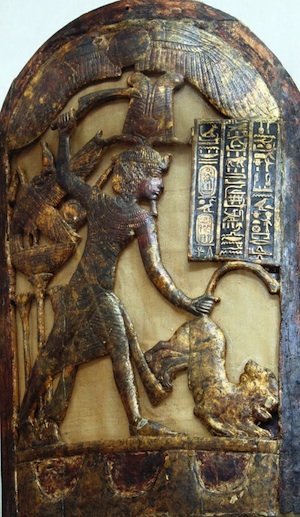
Ceremonial gilded wooden shield from the tomb of Tutakhamun. Egyptian Museum, Cairo (New Kingdom) (photo: Dr. Amy Calvert)
Egyptian artists likewise used a multifariousness of woods in their work, including the native acacia, tamarisk, and sycamore fig likewise as fir, cedar, and other conifers imported from Syria. Artisans excelled at puzzling together modest, irregular pieces of forest and pegged them into place to create statuary, coffins, boxes, and piece of furniture.
Metals
They also executed pieces in various metals, including copper, copper alloys (such as statuary), gold, and argent. Cult statues of gods were made in gold and silver—materials identified by myth as their peel and bones—and were often quite pocket-size. Very few metal statues survive considering they were often melted downwards and the material reused, although preserved examples from the Old and Middle Kingdoms demonstrate that they were skilled not but in sheet metallic forming, simply as well practiced complex casting.

Tutankhamun's lunar pectoral in the Egyptian Museum, Cairo (New Kingdom) (photo: Dr. Amy Calvert)
Jewelry work was quite sophisticated even in the Old Kingdom, as demonstrated past some highly artistic pieces depicted in tomb scenes. A cache of royal jewelry from the tombs of Middle Kingdom princesses displays extremely high levels of skill in terms of blueprint too as precisely cut stone inlays, repoussé, and cloisonné
Many objects, peculiarly pocket-size amulets and inlays, were made from a manufactured textile known as Egyptian faience. This quartz-based medium could exist easily shaped, molded, and mass produced. The glaze coating could exist almost whatever color, depending on the minerals used in the composition, although turquoise blue is the nearly common.
Relief sculpture
Relief was usually carved before being painted. The two principal classes of relief are raised relief (where the figures stand up out from the surface) and sunk relief (where the figures are cut into and beneath the surface). The surface would exist smoothed with a layer of plaster and so painted. If the surface was not carved before painting, several layers of mud plaster would be applied to create a apartment plane.
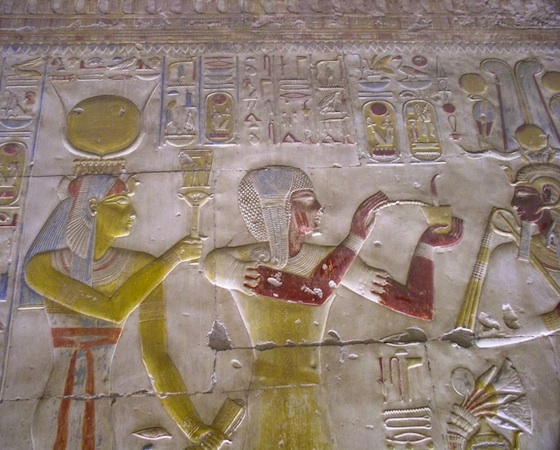
Painted raised relief in the Temple of Seti I at Abydos (New Kingdom)
The drawing surface would exist delineated using gridded guidelines, snapped onto the wall using string coated in red pigment dust (very much like chalk lines used past modern carpenters). This grid helped the artists properly proportion the figures and lay out the scenes. Scene elements were drafted out using red paint, corrections noted in black paint, and then the painting was executed one color at a time. Even on carved relief, many elements in a scene would be executed only in pigment and not cut into the surface.

Iron oxide nodules, source of a range of red pigments, Thebes
Pigments
Almost pigments in Arab republic of egypt were derived from native minerals. White was often made from gypsum, blackness from carbon, reds and yellows from fe oxides, blue and light-green from azurite and malachite, and bright yellow (representing golden) from orpiment. These minerals were ground and so mixed with a establish or animal based mucilage to make a medium able to adhere to the walls. They could be applied as a single aeroplane, but were too layered to create subtle effects and additional colors, such as pink or gray.
Additional resources:
Well-nigh quarrying
Paint like an Egyptian activity
Colour symbolism in ancient Arab republic of egypt
Nicholson, P. & Ian Shaw, Ancient Egyptian Materials and Applied science (Cambridge Academy Press, 2000)
Smarthistory images for teaching and learning:
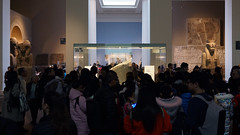
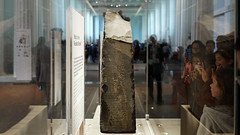
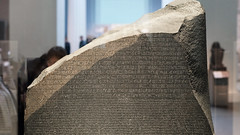
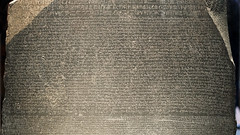
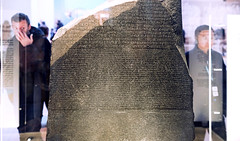
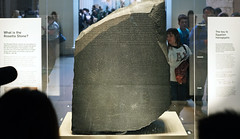
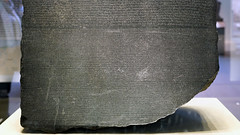
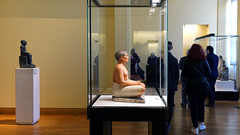
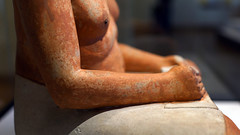
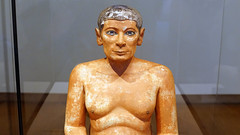
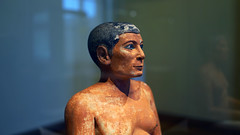

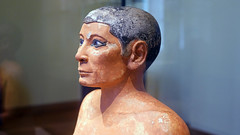
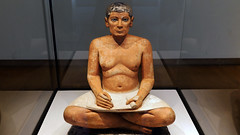
More Smarthistory images…
schoenbergpridn1986.blogspot.com
Source: https://smarthistory.org/materials-and-techniques/
Post a Comment for "What Did the Egyptians Use to Make Thier Art"